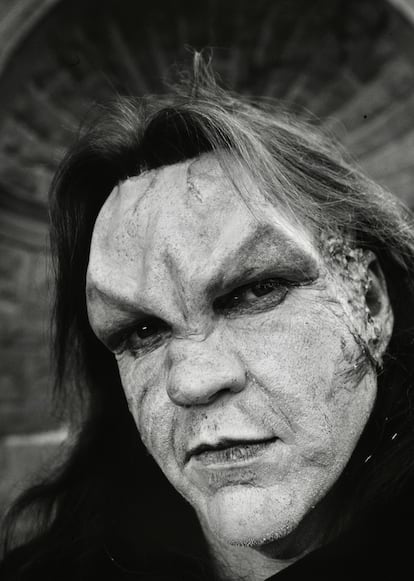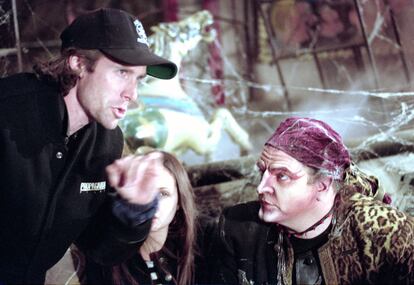A fight between geniuses and a 12-minute-long enigma: When Meat Loaf sang the last great rock ballad
The song ‘I’d Do Anything for Love (But I Won’t Do That)’ turns 30. It’s an example of everything that a great hit cannot be in the era of Spotify: long, excessive, mysterious and expensive

“I have travelled across the universe through the years to find her. Sometimes going all the way is just a start…”
With this caption — accompanied by the roar of a powerful motorcycle going full speed, stalked by cars, motorcycles and a police helicopter — is how the music video for I’d Do Anything for Love (But I Won’t Do That) begins. In the background, there’s an imposing Gothic-style mausoleum, where a creature with brutal features has hidden.
This song by the rocker Meat Loaf (born Marvin Lee Aday, in Nashville) went to the top of the charts in 28 countries in 1993. Three decades later – amidst the era of minimalism, of the instantaneous, of trap hits that don’t last for even two minutes – it shines as the last great exponent of a way of making music. It was spectacular, bombastic, larger than life. And that phenomenon, now that we live under the dictatorship of the algorithm, can hardly be repeated.
I’d Do Anything for Love (But I Won’t Do That) was the first single from the album Bat Out of Hell II: Back into Hell, which marked the artist’s return to success. This was the sequel to his 1977 bestselling album, Bat Out of Hell, which has sold 43 million copies worldwide to date.
The years that separated the two albums were filled with health problems, legal disputes and a handful of releases of modest success. The 16-year-long period also saw Jim Steinman, the composer behind the epic sound and overwhelming lyrics of Meat Loaf’s debut, distance himself personally and professionally from his former friend.
Jim Steinman’s music sounded like the result of a collaboration between Phil Spector and Richard Wagner: he played everything with theatricality and explosiveness. Steinman’s name is behind hits such as Total Eclipse of the Heart, by Bonnie Tyler, or Making Love out of Nothing at All, by Air Supply. According to what Bonnie Tyler revealed just a few months ago, Meat Loaf was furious when he discovered that Jim Steinman had given Total Eclipse of the Heart to her… and even more so when it became the worldwide success that he needed to boost his career in the 1980s. He maintained that the song had been originally written for him, but his record company refused to accept Steinman’s conditions and fees. However, the successful songwriter – who passed away in 2021 – always maintained that, from the beginning, it was always intended for Tyler.
Steinman’s reconciliation with Meat Loaf at the beginning of the 1990s would allow them to triumph with a powerful rock ballad just two years after Nirvana revolutionized the genre with their album Nevermind.

The music video was directed by Michael Bay, who was already beginning to stand out for his spectacularity in both music videos and advertisements. This was before he began a prosperous career in action and adventure cinema, with iconic movies such as Bad Boys, Armageddon or Pearl Harbour. I’d Do Anything for Love is a seven-minute-long frenzy full of beauty and decadence, starring Meat Loaf and the model Dana Patrick. And this is the short version: the one on the album (which 14 million people have bought) lasted 12 minutes. In that timespan, you could play today’s average popular song seven times.
A rock opera in the middle of the grunge era
Today, perhaps there are those who identify 1993 with Creep, by Radiohead, Mr. Jones, by Counting Crows or What’s up?, by 4 Non Blondes. But the truth is that I’d Do Anything for Love (But I Won’t Do That) – released in August of that same year – found its place on the charts next to Whitney Houston, Madonna, Bon Jovi and Aerosmith. Of all of them, Meat Loaf’s song is the most excessive. You would have to go back to Hey Jude by the Beatles to find a song so long that was so successful… and you’d have to wait for almost 10 minutes of All Around the World (1998) by Oasis to find a successor.
All the imagery shown in Michael Bay’s music video is an expanded reflection of what the song offers. The fantasy of a character halfway between the Phantom of the Opera and Beauty and the Beast – the vampiric Gothic or the impossible love story – connected perfectly with Jim Steinman’s lyrics. The songwriter’s love for musicals (he managed to produce several, one of them alongside Andrew Llloyd Weber) is very noticeable in the clip.


Steinman was responsible for choosing the performer of one of the great successes of the song: the duet in the final part, which reveals Meat Loaf’s impossible love. While the names of Cher, Melissa Etheridge or Bonnie Tyler would have been considered, it was an unknown British singer with a prodigious voice – Lorraine Crosby – who ended up taking the assignment. Crosby was performing with her rock band on North American military bases around the world when Jim Steinman decided to sign her to his short-lived agency, after hearing a demo. The singer and her husband, Stuart Emerson, were participating in the chorus during the recording sessions for Bat Out of Hell II: Back into Hell when the opportunity arose to record the duet. “I was just helping out in a crucial moment,” Crosby would say, years later. “The idea wasn’t that it would be used.” But six months later, Meat Loaf himself suggested using the improvised recording.
Her exceptional contribution to the song didn’t lead her to stardom, as one might assume. On the album, she appears credited with what was going to be her stage name – Ms. Loud – and in the music video, it’s the model Dana Patrick who appears “singing,” which meant that she was the one who received offers from various record labels. Meanwhile, Crosby saw her contract cancelled after the split between Jim Steinman and MCA Records, due to the cost overruns of Bat Out of Hell II: Back into Hell. This overspending was due to the spectacular design of the album, and also to the very long 22 months that Meat Loaf took to record it.
Lorraine Crosby never charged for participating in the recording session. She only found out that she was entitled to royalties when it was too late to claim what had been accumulating during the six years following the release of the single. She returned to the United Kingdom, where she dedicated herself to performing in cabarets and amusement parks. She didn’t release her first album (self-released) until 2008.
I’d Do Anything for Love (But I Won’t Do That) was also the milestone that allowed Meat Loaf to become more than just a musician. “There are very few people who sound like [him]. And that, in pop music, is already winning half the battle,” highlights popular culture expert José Viruete. He also adds that Meal Loaf was a very fun guy to listen to. “He did some very good interviews and he spent a lot of time on late night shows and other television programs, where he told lots of little stories.”
One of the most recurring anecdotes was Meat Loaf responding to questions about what he was referring to when he sang “I won’t do that” in his song. The artist, sometimes even using a blackboard, explained that the answer was repeated several times in the lyrics. Among the things that the singer claims he would do for love, he includes some of the things that he would not do, such as “stop dreaming about you” or “do it better than I do with you.” When the female voice suggests that he should realize that it’s time to let her go and move on, he clarifies again: “I won’t do that.” Mystery solved.
To the rhythm of the Royal Guard
Viruete has a special connection with Bat Out of Hell II: Back into Hell. “It’s the first album that I bought with my own money,” he recalls. Viruete also remembers how the music video had a constant presence on MTV and the various music video programs of the 1990s, although he believes that the song becomes truly important in its 12-minute-long record version.”If you’re going to listen to something that grandiose, you have to listen to the full version. The duration is part of that majesty.”
Finally, the critic highlights the significance of an artist who knew how to adapt to the times and work with his own persona, whether that meant playing extreme characters in films such as Fight Club, or letting Seth Rogen convince him to be represented as a piece of meat in a cameo for his animated film Sausage Party.
Meat Loaf died at the beginning of 2022, at the age of 74. His death brought back I’d Do Anything for Love (But I Won’t Do That) to millions of people, including the British Royal Guard, who paraded through Buckingham Palace to the song as a tribute. Dozens of articles were penned analyzing Meat Loaf’s genius. This piece – written 30 years after the last great larger-than-life rock ballad – is another one of them.
Sign up for our weekly newsletter to get more English-language news coverage from EL PAÍS USA Edition
Tu suscripción se está usando en otro dispositivo
¿Quieres añadir otro usuario a tu suscripción?
Si continúas leyendo en este dispositivo, no se podrá leer en el otro.
FlechaTu suscripción se está usando en otro dispositivo y solo puedes acceder a EL PAÍS desde un dispositivo a la vez.
Si quieres compartir tu cuenta, cambia tu suscripción a la modalidad Premium, así podrás añadir otro usuario. Cada uno accederá con su propia cuenta de email, lo que os permitirá personalizar vuestra experiencia en EL PAÍS.
¿Tienes una suscripción de empresa? Accede aquí para contratar más cuentas.
En el caso de no saber quién está usando tu cuenta, te recomendamos cambiar tu contraseña aquí.
Si decides continuar compartiendo tu cuenta, este mensaje se mostrará en tu dispositivo y en el de la otra persona que está usando tu cuenta de forma indefinida, afectando a tu experiencia de lectura. Puedes consultar aquí los términos y condiciones de la suscripción digital.
More information
Archived In
Últimas noticias
Most viewed
- Oona Chaplin: ‘I told James Cameron that I was living in a treehouse and starting a permaculture project with a friend’
- Reinhard Genzel, Nobel laureate in physics: ‘One-minute videos will never give you the truth’
- Sinaloa Cartel war is taking its toll on Los Chapitos
- Why the price of coffee has skyrocketed: from Brazilian plantations to specialty coffee houses
- Silver prices are going crazy: This is what’s fueling the rally










































